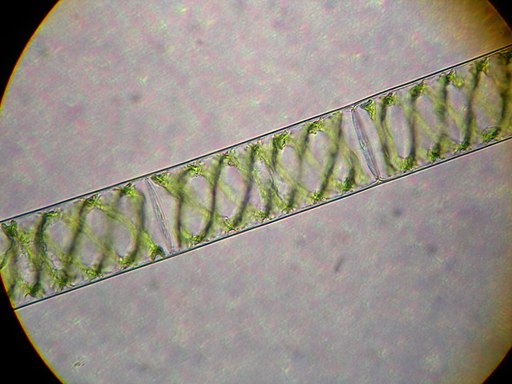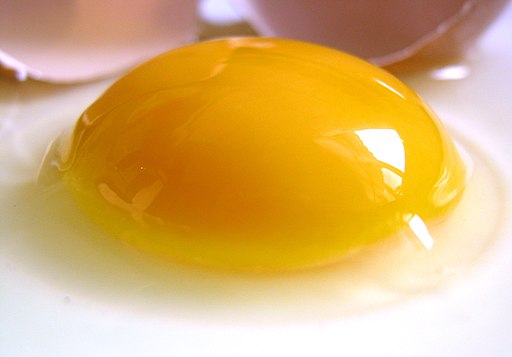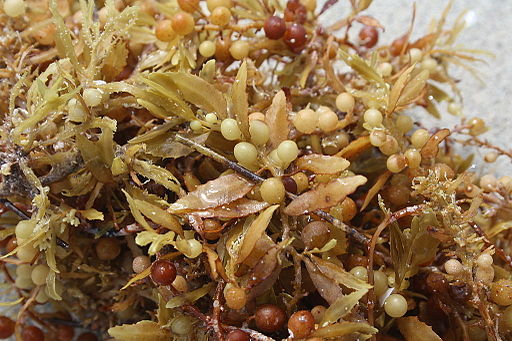Algae show great diversity in pigmentation. Many coloured pigments such as green, red, yellow, and blue have been found in marine and freshwater algae. Different groups of algae have different and specific pigment composition. Pigments are usually found in specialized plastids called chromophores in all groups of algae except in the members of Cyanophyceae (blue green algae). Distribution pattern of pigments has great taxonomic significance in algal systematics. Classification of algae proposed by Fritsch is primarily based of the pigmentation of algae.
Pigments in Algae
Ø All major algal groups have at least one characteristic pigment in their cells.
Pigments in algae belong to THREE major categories based on their physical and chemical properties.
(1). Chlorophylls
(2). Carotenoids
(3). Phycobilins
(1). Chlorophylls
Green algae: Spirogyra (source wikipedia)
Ø Chlorophylls are fat soluble green pigments
Ø They are chlorins which absorb blue region and reflect green light
Ø Chlorophylls are responsible for the green colour of algae and other higher plants.
Seven different types of chlorophylls are reported in algae. They are:
(a). Chlorophyll-a (C55H72O5N4Mg)
(b). Chlorophyll-b (C55H70O6N4Mg)
(c). Chlorophyll–c1 (C35H30O5N4Mg)
(d). Chlorophyll-c2 (C35H28O5N4Mg)
(e). Chlorophyll-d (C54H70O6N4Mg)
(f). Chlorophyll-e (C54H70O6N4Mg)
(g). Chlorophyll-f (C55H70O6N4Mg)
Ø Chlorophyll-a : Present in all groups of algae
Ø Chlorophyll-b : Present in Chlorophyta (green algae)
Ø Chlorophyll-c : Present in Bacillariophyceae (diatoms)
Ø Chlorophyll-d : Present in the members of Rhodophyceae (red algae)
Ø Chlorophyll-e : Present in Xanthophyceae.
Ø Chlorophyll-f : Recently discovered chlorophyll from stromatolites, possibly produced by Cyanobacteria
(2). Carotenoids
Ø Carotenoids are fat soluble yellow pigments present in algae
Ø Carotenoids are found in close association with chlorophylls.
Ø They protect chlorophylls from photo-damage (solarization)
Ø Chemically carotenoids are tetraterpenoids
Ø Carotenoids are present in almost all algal groups.
Ø Carotenoids with beta-ionone ring have Vitamin-A like activity
Ø All carotenoids are strong antioxidants
Yellow colour of egg yolk is due to carotenoids (source wikipedia)
Two types of carotenoids are found in algae.
(1). Carotenes
Ø Carotenes are yellow coloured pigments
Ø They are unsaturated fat soluble hydrocarbons
Ø They do not contain oxygen
Ø They absorb blue and green light and transmit yellow and red light.
Ø Examples: α-carotene, β-carotene, and lycopene
(2). Xanthophylls
Ø Xanthophylls are also called as carotenols
Ø They are oxygen derivatives of carotenes.
Ø Example: lutein and zeaxanthin (both are responsible for the yellow colour of egg yolk)
(3). Phycobilins
Blue colour of Cyanophyceae due to Phycocyanins (source wikipedia)
Ø Phycobilins are water soluble pigments
Ø Phycobilins are always bonded with some water soluble proteins called phycobiliproteins
Ø They are blue and red in colour
Ø They are present in Cyanophyceae and Red algae
Ø Phycobilins are usually found in organisms living in deep water for the efficient absorption of light
Ø All phycobilins are strongly fluorescent
Ø They emit orange or red light after fluorescence.
Two classes of phycobilins are present in algae.
(1). Phycocyanin
Ø Phycocyanin are blue coloured pigments
Ø They are blue green algae pigments
Ø Phycocyanins are also present in red algae
Ø They absorb green, yellow and red light and transmit blue colour.
Ø Phycocyanins are the principal pigment of Cyanophyceae.
(2). Phycoerythrin
Red colour of Red Algae due to Phycoerythrin (source wikipedia)
Ø Phycoerythrin are red coloured pigments
Ø Phycoerythrin are red algae pigments
Ø They absorb blue green, green and yellow light and transmit red light.
Ø Phycoerythrin present abundantly in members of Rhodophyceae (red algae)
| You may also like... | ||
|---|---|---|
| NOTES | QUESTION BANK | COMPETITIVE EXAMS. |
| PPTs | UNIVERSITY EXAMS | DIFFERENCE BETWEEN.. |
| MCQs | PLUS ONE BIOLOGY | NEWS & JOBS |
| MOCK TESTS | PLUS TWO BIOLOGY | PRACTICAL |
Distribution pattern of different pigments in different algal groups
Ø All photosynthetic algae contain chlorophylls, carotenoids and Xanthophylls.
Ø Members of Cyanophyceae (Myxophyceae = blue green algae) and Rhodophyceae (red algae) contain large amount phycobilins, particularly phycocyanins.
Distributions of individual pigments in specific algal group are summarized in the following table:

Sargassum, a brown algae (source wikipedia)
Key questions
What are the major pigments of algae?
What are different types of Chlorophylls present in algae?
What are carotenoids?
What are phycobilins?
What are phycocyanin and phycoerythrin?
What are green algae pigments?
What are brown algae pigments?
What are red algae pigments?
What Blue Green Algae pigments
What are the pigments of Diatoms?
What are the importance of pigments in algal classification and systematics?
You may also like…
@. Algae: General Characters (key points) with PPT
@. Biology PPT





